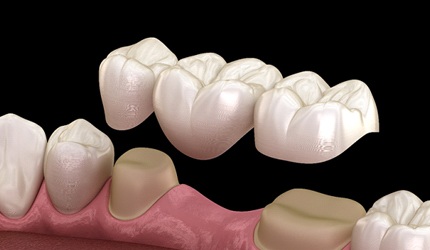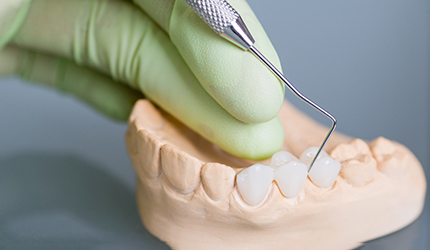
Dental Bridges – DeSoto, TX
Saying Good-Bye to Gaps
When a tooth is lost, the adjacent teeth have a tendency to shift into the empty space. Fortunately, there’s a way to hold them in place and fill the gap at the same time: a dental bridge. Like all of the restorations at Amaze Dental, our dental bridges are personalized for each patient to perfectly match their smiles and restore their oral health. If you have a missing tooth or think you might need to have an extraction performed in the future, now’s the time to learn more about dental bridges by calling our office to schedule a consultation with Dr. Najjar.
Why Choose Amaze Dental for Dental Bridges?
- Implant-Retained Bridges Available
- Digital Impressions for Advanced Planning
- Natural-Looking, Long-Lasting Restorations
What is a Dental Bridge?

A dental bridge replaces one or more missing teeth so that you can chew and talk normally, improve the alignment of your remaining teeth, and maintain the shape of your face. The bridge is made up of two dental crowns and at least one prosthetic tooth, all made out of lifelike ceramic that is custom-shaded and shaped to match the rest of your smile. The teeth next to the gap will be prepared so that the crowns can be attached to them, allowing the prosthetic tooth or teeth between them to fill in the empty space.
Sometimes a dental bridge can be anchored to implants instead of natural teeth. This is normally done if you’ve lost three or more teeth that were all right next to each other. Implant-retained bridges let you preserve the natural enamel of your remaining teeth, and the implant posts will help stop the jawbone from breaking down and changing the shape of your mouth.
What is the Procedure Like?

For a traditional dental bridge, you’ll normally need at least two appointments. During the first, the relevant teeth will be altered to create room for the future restoration. An impression will be taken of your mouth in its current state, and the data will be sent to a separate lab. It may take a couple of weeks for them to precisely design a restoration that will perfectly fit in your mouth and fill in the empty space. We’ll contact you when the restoration is ready for placement.
What are the Benefits?

- A dental bridge is a very lightweight and comfortable restoration that will let you speak and chew with ease. This also ensures that it won’t put an excessive amount of pressure on the gums whenever you bite down.
- Your new teeth will be permanently fixed in place, and you can brush and floss them as you would your natural teeth.
- The bridge will help you maintain healthy facial structure by holding the adjacent teeth and underlying jaws in place.
- A traditional dental bridge can be placed in as little as two appointments.
Dental Bridges FAQs

Are you missing one or several teeth in a row? If so, a dental bridge may be one of the best solutions for your smile. While you can expect to appreciate essential benefits from this restoration, replacing your missing pearly whites is a major decision. To help you feel well-informed and confident about your treatment, our team at Amaze Dental has compiled and answered some of our most common questions about a dental bridge in DeSoto. Read on or give us a call today to learn more or if you don’t see the information you’re looking for!
How Many Teeth Can a Dental Bridge Replace?
While this will typically depend on the patient’s specific needs, a dental bridge can replace about one to four consecutive missing teeth. That said, in the majority of cases, these restorations are used to renew only one or two teeth. This is because the longer a traditional dental bridge extends across your smile, the less stability it’ll have, especially if the abutment teeth supporting them on either side aren’t strong and healthy. Implant bridges, however, can significantly lower this risk, as the metal posts will provide stability similar to your natural pearly whites.
Can You Take a Dental Bridge Out?
You should not be able to remove a dental bridge on your own. They are designed to remain in your mouth for years to come after being placed. The only one who can take them out properly is your dentist. Unfortunately, some healthcare professionals refer to partial dentures as “removable bridges,” but these two restorations shouldn’t be confused. Though partials are similar to bridges in that they replace multiple missing teeth in a row, the main difference is that the former can be removed at any point by the patient, whereas bridges cannot.
Do Dental Bridges Feel Natural?
Your dental bridge should begin to feel significantly more natural within several days of receiving them. These restorations are constructed out of durable ceramic material that’s capable of withstanding the excessive pressures of chewing just like your tooth enamel. This means you should have a normal time munching on your favorite foods. Your bridge will also be smooth and specifically shaped to fit seamlessly with the rest of your smile. For this reason, you shouldn’t feel any notable differences between your restoration and your permanent teeth.
Is Getting a Dental Bridge Painful?
Like with most of our other dental procedures, we will first numb your mouth completely with a local anesthetic before beginning work on your smile. Once we verify that you’re comfortable, we’ll start by preparing your teeth to support the restoration. You shouldn’t feel any discomfort during the appointment itself, but it’s normal to experience some sensitivity a few days following your visit. Fortunately, this can easily be managed with over-the-counter pain medications. However, be sure to notify us if any discomfort persists. Furthermore, bridges can prevent your nearby teeth from drifting out of place, which in turn helps avoid pain in the long run.